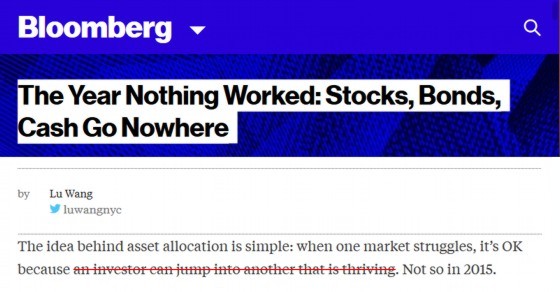I was astonished to find a recent Bloomberg article that opened with: “The idea behind asset allocation is simple: when one market struggles, it’s OK because an investor can jump into another that is thriving. Not so in 2015.”
The article was entitled, “The Year Nothing Worked: Stocks, Bonds, Cash Go Nowhere” and it betrays a total lack of comprehension about how wise asset allocation works. This theory of investing is common but fundamentally flawed.
The basic error is assuming you know what the market is doing right now. Lu Wang, the article’s author, says that when one market struggles, you can jump into another that “is thriving” – present tense. But all available data is based on past performance. All we know is what the market has done recently and, as any investment professional knows and is required to tell clients, past performance is no guarantee of future returns.
That error in thinking leads investors, investment managers, and investment columnists to believe that they can predict what is just taking off and score better returns than if they rode out a temporary dip in price. These people forget that they can be wrong. When you combine the mistakes these people make by chasing returns and the trading fees involved in constantly changing your investment strategy, the investment strategy Lu Wang recommends can perform worse than a monkey throwing darts. Worse, even though the stock market trends upward in the long run, all investments move up and down in the short run. Buying what seems to be thriving often means buying a stock at its most expensive point. This is the opposite of what you want to do: buy low and sell high.
It is bad enough to have commission-based brokers trying to confuse investors with deceptive language, hidden fees, and promises of long-term investment gains that rely on risky short-term thinking that benefits the brokers at their customers’ expense. Investors should not have to deal with financial reporters that misunderstand the field they write about.
But unfortunately for regular investors, the financial news media is its own separate business. We’re wired to respond to negative stimuli more strongly than positive ones, so it’s easier to make a repeat customer by troubling your audience with short-term hysteria.
Wise investing means setting a good asset allocation for the long term and regularly rebalancing back to that plan. It means selling high and buying low. It is always a contrarian move because to people who can’t escape a short-term perspective, it looks like selling a winning stock and buying a loser. But this contrarian thinking can boost returns by 1.6% a year. Chasing returns, as Lu Wang recommends, may underperform a buy-and-hold strategy by as much as 1.4% for some asset classes.
By playing into the weaknesses we are born with, this article harms those who read it.
Carl Richards writes that, “for most clients, paying attention to financial media distracts them from their primary goals.” He continues :
For instance, one friend shared with me that when he turned off the financial news spigot, he calculated that he saved two to three hours every night. Do the math and it ends up being a savings of 40 or so days a year. Even if you cut that in half, it’s still 20 more days in a year to do something else besides trying to translate the noise masquerading as financial news.
Daniel Crosby, writing for Wealth Management Magazine , offers tips for “safe watching” if you find yourself exposed to alarmist financial news:
- Evaluate the source – does this individual have the appropriate credentials to speak to this matter or were they chosen for superfluous reasons such as appearance, charisma or bombast?
- Question the melodrama – while volatility can be the enemy of good investing, chaos and uncertainty are a boon to media outlets hungry for clicks and views.
- Examine the tone – does the report use loaded language or make ad hominem attacks? These are more indicative of an agenda that an actual story.
- Consider motive – news outlets are not charitable organizations and are just as profit-driven as any other business. How might the tenor of this report benefit their needs over yours as a decision-maker?
- Check the facts – are the things being presented consistent with best academic practices and the opinions of other experts in the field? Are facts or opinions being expressed and in what research are they grounded?
When you cut through the false assumptions, the sensational language, and the errors in thinking, you can finally rest assured that your plan is a wise one. Stick to your long-term asset allocation plans. Rebalance regularly. These are the keys to long-term wealth, not the next hot thing.
